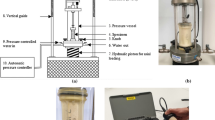Abstract
An extensive experimental program has been set up to characterize the time-dependent deformation behavior of masonry, subjected to the creep failure mode. Different types of short-term creep tests were performed on small masonry specimens, which were constructed with air-hardening lime mortar. To assess the influence of the carbonation process on creep behavior, several specimens were subjected to accelerated carbonation. The time-dependent deformations are modeled using a viscoelastic, rheological model which includes damage effects. The applicability of the model is validated by comparing theoretical and experimental results and extending the time frame to long-term predictions. Good agreement was found between experimental and simulated time-dependent deformations. The accuracy of the proposed model is estimated by including the scatter on the most important material parameters in the analysis.


















Similar content being viewed by others
References
Binda L (2008) Learning from failure—long-term behaviour of heavy masonry structures, vol 23 of Advances in architecture. WIT Press, Southampton
Anzani A, Binda L, Roberti GM (2000) The effect of heavy persistent actions into the behaviour of ancient masonry. Mater Struct 33(228):251–261
Pina-Henriques J, Lourenço PB (2003) Testing and modelling of masonry creep and damage in uniaxial compression. Struct Stud Repairs Maint Herit Archit VIII 16:151–160
van Zijl GPAG (2000) Computational modelling of masonry creep and shrinkage. PhD, Delft Univ. of Technology, The Netherlands
Choi KK, Lissel SL, Taha MMR (2007) Rheological modelling of masonry creep. Can J Civil Eng 34(11):1506–1517
Ferretti D, Bažant ZP (2006) Stability of ancient masonry towers: moisture diffusion, carbonation and size effect. Cem Concr Res 36(7):1379–1388
Verstrynge E, Ignoul S, Schueremans L, Van Gemert D, Wevers M (2008) Application of the acoustic emission technique for assessment of damage-accumulation in masonry. Int J Restor Build Monum 14(3):167–178
Anzani A, Binda L, Roberti GM (1995) A numerical interpretation of long-term behaviour of masonry materials under persistent loads. Structural studies of historical buildings IV—vol 1: architectural studies, materials and analysis, pp 179–186
Verstrynge E, Ignoul S, Schueremans L, Van Gemert D (2008) Modelling of damage accumulation in masonry subjected to a long-term compressive load. In: D’Ayala D, Fodde E (eds) 6th international seminar on structural analysis of historical constructions. University of Bath, Bath, pp 525–532
Papa E, Taliercio A (2005) A visco-damage model for brittle materials under monotonic and sustained stresses. Int J Numer Anal Methods Geomech 29(3):287–310
Garavaglia E, Anzani A, Binda L (2006) Probabilistic model for the assessment of historic buildings under permanent loading. J Mater Civil Eng 18(6):858–867
Verstrynge E, Schueremans L, Van Gemert D (2009) Service life prediction of masonry under high loading: modelling and probabilistic evaluation. In 10th international conference on structural safety and reliability, Osaka, 2009
Van Balen K, van Bommel B, van Hees R, van Hunen M, van Rhijn J, van Rooden M (2003) Kalkboek: Het gebruik van kalk als bindmiddel voor metsel- en voegmortels in verleden en heden (in Dutch). Rijksdienst voor Monumentenzorg, Zeist
Van Balen K, Van Gemert D (1994) Modeling lime mortar carbonation. Mater Struct 27(171):393–398
Forth JP, Brooks JJ, Tapsir SH (2000) The effect of unit water absorption on long-term movements of masonry. Cem Concr Compos 22(4):273–280
Boukharov GN, Chanda MW, Boukharov NG (1995) The three processes of brittle crystalline rock creep. Int J Rock Mech Min Sci Geomech Abstr 32(4):325–335
Anzani A, Binda L, Taliercio A (2005) Application of a damage model to the study of the long term behaviour of ancient towers. In 1st Canadian conference on effective design of structures, Ontario
Bland DR (1960) The theory of linear viscoelasticity, vol 10 of Pure and applied mathematics. Pergamon Press, New York
Tschoegl N (1989) The phenomenological theory of linear viscoelastic behavior. Springer, Berlin
Krajcinovic D, Lemaitre J (1987) Continuum damage mechanics: theory and applications. Springer, Berlin
Challamel N, Lanos C, Casandjian C (2005) Creep damage modelling for quasi-brittle materials. Eur J Mech A 24(4):593–613
Bodner SR, Chan KS (1986) Modeling of continuum damage for application in elastic-viscoplastic constitutive equations. Eng Fract Mech 25(5–6):705–712
Binda L, Schueremans L, Verstrynge E, Ignoul S, Oliveira DV, Lourenço PB, Modena C (2008) Long term compressive testing of masonry—test procedure and practical experience. In D’Ayala D, Fodde E (eds) 6th international seminar on structural analysis of historical constructions. University of Bath, Bath, pp 1345–1355
Acknowledgements
The authors express their thanks to the Flemish Fund for Scientific Research (FWO) for the doctoral grant, offered to Els Verstrynge. The authors highly appreciate the collaboration with the Politecnico di Milano and the University of Minho in this research area.
Author information
Authors and Affiliations
Corresponding author
Rights and permissions
About this article
Cite this article
Verstrynge, E., Schueremans, L. & Van Gemert, D. Time-dependent mechanical behavior of lime-mortar masonry. Mater Struct 44, 29–42 (2011). https://doi.org/10.1617/s11527-010-9606-8
Received:
Accepted:
Published:
Issue Date:
DOI: https://doi.org/10.1617/s11527-010-9606-8




